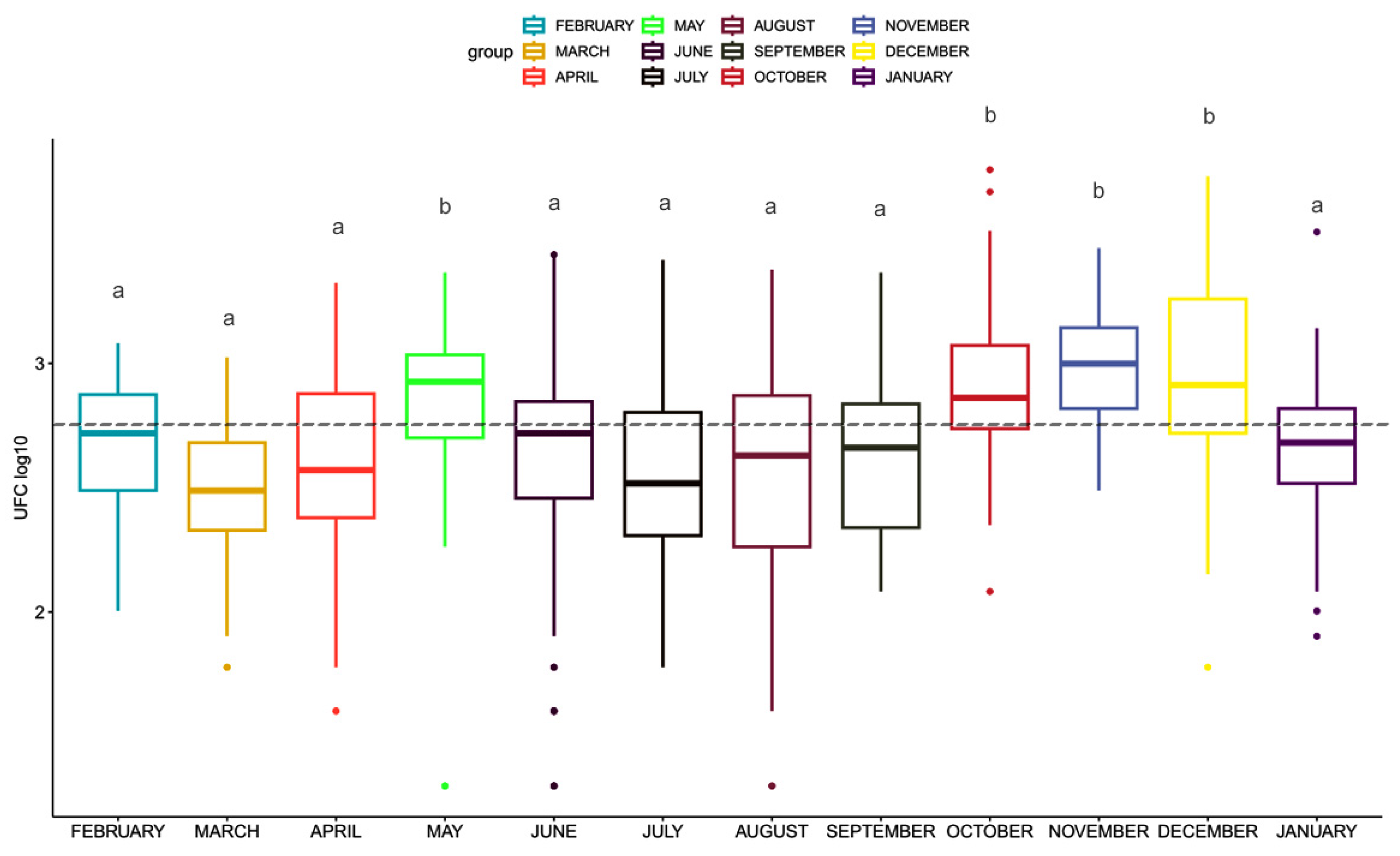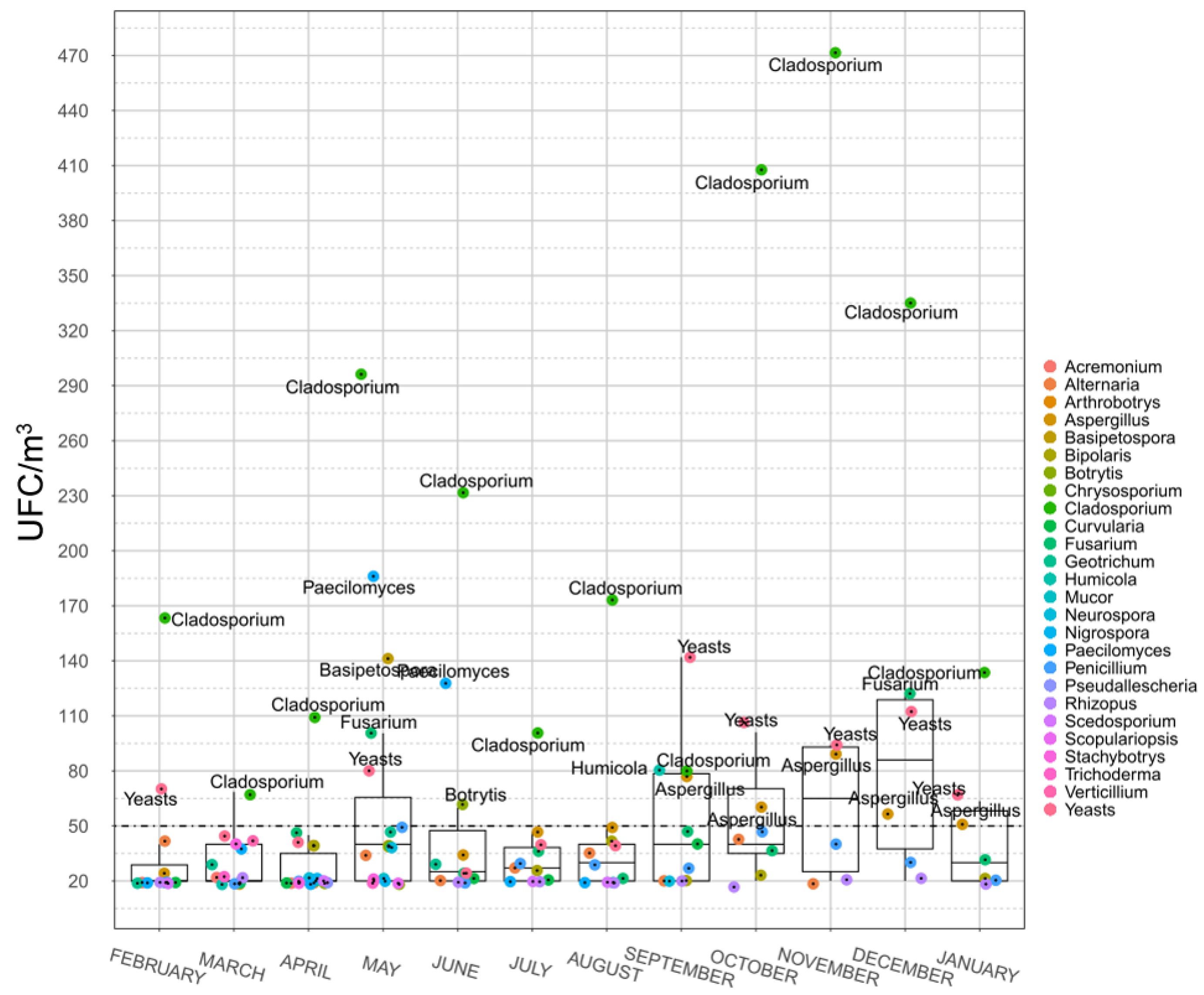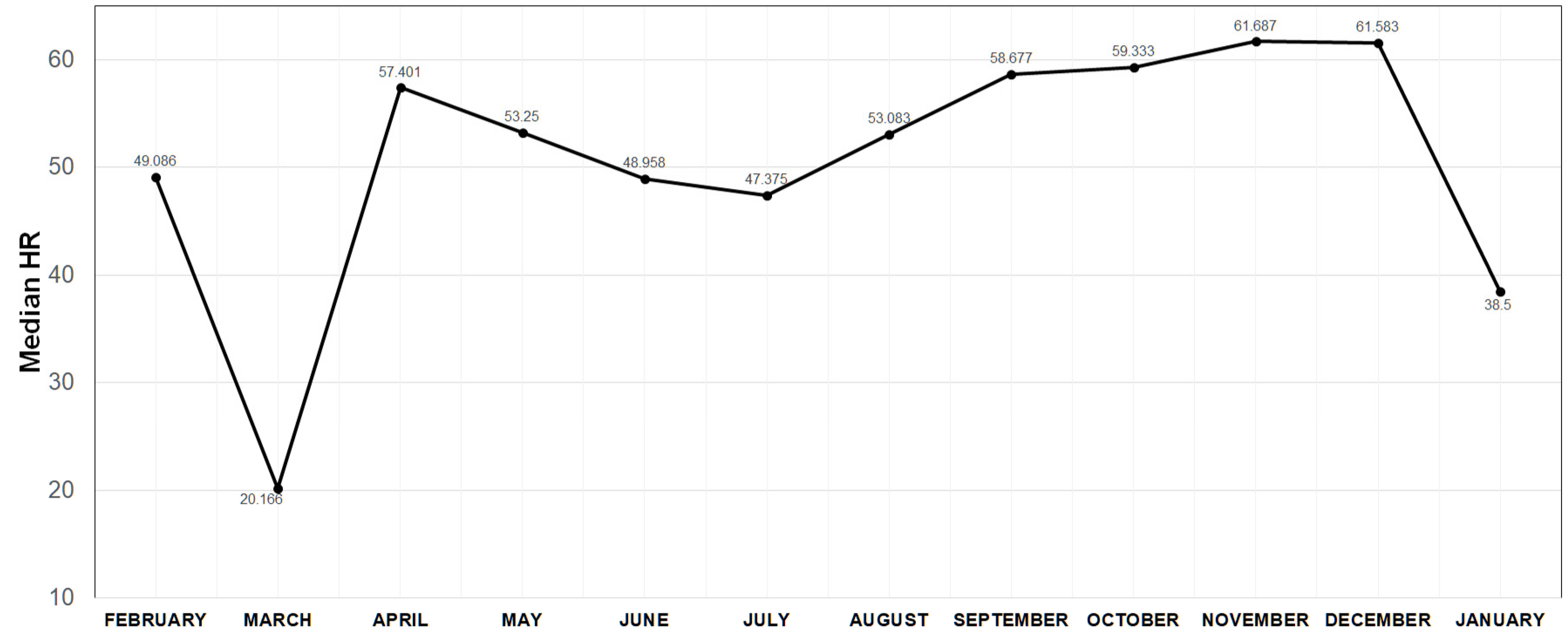Culturable Airborne Fungi in Downtown Monterrey (Mexico) and Their Correlation with Air Pollution over a 12-Month Period
Abstract
:1. Introduction
2. Materials and Methods
2.1. Area of Study
2.2. Sampling Method
2.3. Fungal Quantitation and Identification
2.4. Pollution Data Retrieval and Analysis
2.4.1. Statistical Analysis
2.4.2. Fold Change Analysis
3. Results
Airborne Fungi Diversity and Concentration
4. Discussion
5. Conclusions
Author Contributions
Funding
Institutional Review Board Statement
Informed Consent Statement
Data Availability Statement
Acknowledgments
Conflicts of Interest
References
- United States Environmental Protection Agency. Available online: https://www.epa.gov/pmcourse/particle-pollution-and-respiratory-effects (accessed on 19 May 2023).
- World Health Organization. Air Pollution. Available online: https://www.who.int/health-topics/air-pollution#tab=tab_2 (accessed on 3 January 2021).
- Brook, R.D.; Rajagopalan, S.; Pope, C.A., 3rd; Brook, J.R.; Bhatnagar, A.; Diez-Roux, A.V.; Holguin, F.; Hong, Y.; Luepker, R.V.; Mittleman, M.A.; et al. Particulate Matter Air Pollution and Cardiovascular Disease: An update to the scientific statement from the american heart association. Circulation 2010, 121, 2331–2378. [Google Scholar] [CrossRef] [PubMed] [Green Version]
- Cortes, T.R.; Silveira, I.H.; de Oliveira, B.F.A.; Bell, M.L.; Junger, W.L. Short-term association between ambient air pollution and cardio-respiratory mortality in Rio de Janeiro, Brazil. PLoS ONE 2023, 18, e0281499. [Google Scholar] [CrossRef] [PubMed]
- Cosselman, K.E.; Navas-Acien, A.; Kaufman, J.D. Environmental factors in cardiovascular disease. Nat. Rev. Cardiol. 2015, 12, 627–642. [Google Scholar] [CrossRef]
- Yang, Y.-S.; Pei, Y.-H.; Gu, Y.-Y.; Zhu, J.-F.; Yu, P.; Chen, X.-H. Association between short-term exposure to ambient air pollution and heart failure: An updated systematic review and meta-analysis of more than 7 million participants. Front. Public Health 2023, 10, 948765. [Google Scholar] [CrossRef] [PubMed]
- Rook, G.A. Regulation of the immune system by biodiversity from the natural environment: An ecosystem service essential to health. Proc. Natl. Acad. Sci. USA 2013, 110, 18360–18367. [Google Scholar] [CrossRef] [Green Version]
- Mutlu, E.A.; Engen, P.A.; Soberanes, S.; Urich, D.; Forsyth, C.B.; Nigdelioglu, R.; Chiarella, S.E.; Radigan, K.A.; Gonzalez, A.; Jakate, S.; et al. Particulate matter air pollution causes oxidant-mediated increase in gut permeability in mice. Part. Fibre Toxicol. 2011, 8, 19. [Google Scholar] [CrossRef] [Green Version]
- Zhang, L.; Nichols, R.G.; Correll, J.; Murray, I.A.; Tanaka, N.; Smith, P.B.; Hubbard, T.D.; Sebastian, A.; Albert, I.; Hatzakis, E.; et al. Persistent Organic Pollutants Modify Gut Microbiota–Host Metabolic Homeostasis in Mice Through Aryl Hydrocarbon Receptor Activation. Environ. Health Perspect. 2015, 123, 679–688. [Google Scholar] [CrossRef] [Green Version]
- Imbriani, G.; Panico, A.; Grassi, T.; Idolo, A.; Serio, F.; Bagordo, F.; De Filippis, G.; De Giorgi, D.; Antonucci, G.; Piscitelli, P.; et al. Early-Life Exposure to Environmental Air Pollution and Autism Spectrum Disorder: A Review of Available Evidence. Int. J. Environ. Res. Public Health 2021, 18, 1204. [Google Scholar] [CrossRef]
- Calderón-Garcidueñas, L.; Reed, W.; Maronpot, R.R.; Henríquez-Roldán, C.; Delgado-Chavez, R.; Calderón-Garcidueñas, A.; Dragustinovis, I.; Franco-Lira, M.; Aragón-Flores, M.; Solt, A.C.; et al. Brain Inflammation and Alzheimer’s-Like Pathology in Individuals Exposed to Severe Air Pollution. Toxicol. Pathol. 2004, 32, 650–658. [Google Scholar] [CrossRef]
- Anita, W.M.; Ueda, K.; Uttajug, A.; Seposo, X.T.; Takano, H. Association between Long-Term Ambient PM2.5 Exposure and under-5 Mortality: A Scoping Review. Int. J. Environ. Res. Public Health 2023, 20, 3270. [Google Scholar] [CrossRef]
- Martínez-Muñoz, A.; Hurtado-Díaz, M.; Cruz, J.C.; Riojas-Rodríguez, H. Mortalidad aguda asociada con partículas suspendidas finas y gruesas en habitantes de la Zona Metropolitana de Monterrey. Salud Pública México 2020, 62, 468–476. [Google Scholar] [CrossRef] [PubMed]
- Riojas-Rodríguez, H.; da Silva, A.S.; Sangrador, J.L.T.; Moreno-Banda, G.L. Air pollution management and control in Latin America and the Caribbean: Implications for climate change. Rev. Panam. De Salud Pública 2016, 40, 150–159. [Google Scholar]
- IQAir. Available online: https://www.iqair.com/mx/mexico (accessed on 20 May 2023).
- Moelling, K.; Broecker, F. Air Microbiome and Pollution: Composition and Potential Effects on Human Health, Including SARS Coronavirus Infection. J. Environ. Public Health 2020, 2020, 1646943. [Google Scholar] [CrossRef] [PubMed]
- Cao, C.; Jiang, W.; Wang, B.; Fang, J.; Lang, J.; Tian, G.; Jiang, J.; Zhu, T.F. Inhalable Microorganisms in Beijing’s PM2.5 and PM10 Pollutants during a Severe Smog Event. Environ. Sci. Technol. 2014, 48, 1499–1507. [Google Scholar] [CrossRef]
- Góralska, K.; Lis, S.; Gawor, W.; Karuga, F.; Romaszko, K.; Brzeziańska-Lasota, E. Culturable Filamentous Fungi in the Air of Recreational Areas and Their Relationship with Bacteria and Air Pollutants during Winter. Atmosphere 2022, 13, 207. [Google Scholar] [CrossRef]
- Zapata-Morín, P.; Reyna-Martinez, R.; Orue, N.; Treviño-Rangel, R.D.J.; Elizondo-Zertuche, M.; Adame-Rodríguez, J.; Becerra-Siller, Y.; Sánchez-Ovalle, V.; Robledo-Leal, E. The Influence of Carpeting, Human Activity and Number of Beds on Airborne Fungi Concentration in Hotel Bedrooms. Appl. Sci. 2021, 11, 6773. [Google Scholar] [CrossRef]
- Larone, D.H. Medically Important Fungi: A Guide to Identification, 5th ed.; American Society for Microbiology: Washington, DC, USA, 2011. [Google Scholar] [CrossRef]
- Watanabe, T. Pictorial Atlas of Soil and Seed Fungi: Morphologies of Cultured Fungi and Key to Species; CRC Press Taylor & Francis: Boca Raton, FL, USA, 2010. [Google Scholar]
- Guarro, J. Atlas of Soil Ascomycetes; CBS-KNAW Fungal Biodiversity Centre: Utrech, The Netherland, 2007. [Google Scholar]
- Instituto Nacional de Ecología y Cambio Climático—Calidad del Aire. Available online: https://sinaica.inecc.gob.mx/estacion.php?estId=134 (accessed on 1 February 2023).
- Rosas, C.I.O.; Calderón-Ezquerro, M.D.C.; Gutiérrez-Ruacho, O.G. Fungal spores and pollen are correlated with meteorological variables: Effects in human health at Hermosillo, Sonora, Mexico. Int. J. Environ. Health Res. 2019, 30, 677–695. [Google Scholar] [CrossRef]
- Shelton, B.G.; Kirkland, K.H.; Flanders, W.D.; Morris, G.K. Profiles of Airborne Fungi in Buildings and Outdoor Environments in the United States. Appl. Environ. Microbiol. 2002, 68, 1743–1753. [Google Scholar] [CrossRef] [Green Version]
- Pavan, R.; Manjunath, K. Qualitative Analysis of Indoor and Outdoor Airborne Fungi in Cowshed. J. Mycol. 2014, 2014, 985921. [Google Scholar] [CrossRef] [Green Version]
- Calderón-Ezquerro, M.D.C.; Serrano-Silva, N.; Brunner-Mendoza, C. Aerobiological study of bacterial and fungal community composition in the atmosphere of Mexico City throughout an annual cycle. Environ. Pollut. 2021, 278, 116858. [Google Scholar] [CrossRef]
- Zhang, S.; Liang, Z.; Wang, X.; Ye, Z.; Li, G.; An, T. Bioaerosols in an industrial park and the adjacent houses: Dispersal between indoor/outdoor, the impact of air purifier, and health risk reduction. Environ. Int. 2023, 172, 107778. [Google Scholar] [CrossRef]
- Jaakkola, M.S.; Hyrkäs-Palmu, H.; Jaakkola, J.J.K. Residential Exposure to Dampness Is Related to Reduced Level of Asthma Control among Adults. Int. J. Environ. Res. Public Health 2022, 19, 11338. [Google Scholar] [CrossRef] [PubMed]
- Mortelliti, C.L.; Banzon, T.M.; Vieira, C.Z.; Phipatanakul, W. Environmental Exposures Impact Pediatric Asthma Within the School Environment. Immunol. Allergy Clin. N. Am. 2022, 42, 743–760. [Google Scholar] [CrossRef] [PubMed]
- Peeters, S.; Wang, C.; Bijnens, E.M.; Bullens, D.M.A.; Fokkens, W.J.; Bachert, C.; Hellings, P.W.; Nawrot, T.S.; Seys, S.F. Association between outdoor air pollution and chronic rhinosinusitis patient reported outcomes. Environ. Health 2022, 21, 134. [Google Scholar] [CrossRef] [PubMed]
- WHO Fungal Priority Pathogens List to Guide Research, Development and Public Health Action; Licence: CC BY-NC-SA 3.0 IGO; World Health Organization: Geneva, Switzerland, 2022.
- Castro-Fuentes, C.A.; Reyes-Montes, M.D.R.; Frías-De-León, M.G.; Valencia-Ledezma, O.E.; Acosta-Altamirano, G.; Duarte-Escalante, E. Aspergillus-SARS-CoV-2 Coinfection: What Is Known? Pathogens 2022, 11, 1227. [Google Scholar] [CrossRef] [PubMed]
- Estrada, A.R.; Torres, E.M.; Vázquez, M.A.A.; Piñero, J.L.H.; Lucio, M.A.G.; Martínez, S.M.S. Fungal spores in four catholic churches in the metropolitan area of Monterrey, Nuevo León State, Mexico—First study. Ann. Agric. Environ. Med. 2015, 22, 221–226. [Google Scholar] [CrossRef] [Green Version]
- Flores, M.E.; Medina, P.G.; Camacho, S.P.; de Jesús Uribe Beltrán, M.; De la Cruz Otero, M.D.; Ramírez, I.O.; Hernández, M.E. Fungal spore concentrations in indoor and outdoor air in university libraries, and their variations in response to changes in meteorological variables. Int. J. Environ. Health Res. 2013, 24, 320–340. [Google Scholar] [CrossRef]
- Castro E Silva, D.M.; Marcusso, R.M.N.; Barbosa, C.G.G.; Gonçalves, F.L.T.; Cardoso, M.R.A. Air pollution and its impact on the concentration of airborne fungi in the megacity of São Paulo, Brazil. Heliyon 2020, 6, e05065. [Google Scholar] [CrossRef]




| Genus | CFU |
|---|---|
| Cladosporium | 4276 |
| Sterile mycelium | 3764 |
| Yeasts | 2117 |
| Aspergillus | 972 |
| Fusarium | 205 |
| Penicillium | 174 |
| Paecilomyces | 64 |
| Alternaria | 61 |
| Rhizopus | 28 |
| Geotrichum | 17 |
| Bipolaris | 8 |
| Basipetospora | 5 |
| Curvularia | 4 |
| Humicola | 3 |
| Scedosporium complex | 3 |
| Stachybotrys | 3 |
| Botrytis | 2 |
| Acremonium | 2 |
| Trichoderma | 2 |
| Chrysosporium | 1 |
| Neurospora | 1 |
| Mucor | 1 |
| Nigrospora | 1 |
| Verticillium | 1 |
| Arthrobotrys | 1 |
| Phaeoacremonium | 1 |
| Scopulariopsis | 1 |
| Compared Parameters * | Correlation Value (log10) ** | R2 | p-Value |
|---|---|---|---|
| March UFC vs. PM10 | 1.183 | 0.34891129 | 0.016 |
| APRIL UFC vs. NO2 | −1.078 | 0.182168824 | 0.024 |
| APRIL UFC vs. PM10 | −1.392 | 0.246670914 | 0.007 |
| APRIL UFC vs. PM2.5 | −0.878 | NA | 0.003 |
| MAY UFC vs. PM10 | −2.011 | 0.248469855 | 0.004 |
| MAY UFC vs. PM2.5 | −1.036 | 0.18551789 | 0.017 |
| JUNE UFC vs. CO | −0.367 | NA | 0.011 |
| JULY UFC vs. SO2 | −2.324 | 0.208116433 | 0.017 |
| AUGUST UFC vs. NO2 | −0.455 | NA | 0.023 |
| NOVEMBER UFC vs. CO | −0.258 | NA | 0.019 |
| DECEMBER UFC vs. SO2 | −1.153 | 0.228 | 0.010 |
| Compared Parameters * | Genus | Correlation Value (log10) ** | R2 | p-Value |
|---|---|---|---|---|
| February UFC vs. CO | Acremonium | 0.336 | NA | 0.001 |
| February UFC vs. PM10 | Alternaria | 0.675 | NA | 0.008 |
| May UFC vs. NO2 | 0.979 | NA | 0.001 | |
| May UFC vs. NOx | 1.511 | NA | 0.000 | |
| June UFC vs. NO2 | 0.961 | 0.395 | 0.029 | |
| June UFC vs. NOx | 1.094 | 0.356 | 0.041 | |
| June UFC vs. PM2.5 | 3.105 | 0.440 | 0.026 | |
| July UFC vs. CO | −2.953 | 0.399 | 0.012 | |
| August UFC vs. CO | −0.890 | 0.994 | 0.003 | |
| August UFC vs. PM2.5 | 1.982 | 0.985 | 0.008 | |
| October UFC vs. SO2 | −4.654 | 0.695 | 0.020 | |
| October UFC vs. NO2 | 0.789 | NA | 0.001 | |
| October UFC vs. O3 | −0.267 | NA | 0.001 | |
| April UFC vs. PM10 | Aspergillus | 0.725 | 0.224 | 0.019 |
| July UFC vs. CO | 5.495 | 0.247 | 0.011 | |
| September UFC vs. NO2 | −1.446 | 0.224 | 0.047 | |
| October UFC vs. NOx | 0.964 | 0.191 | 0.014 | |
| November UFC vs. SO2 | −1.008 | 0.262 | 0.021 | |
| November UFC vs. CO | −0.370 | NA | 0.014 | |
| November UFC vs. NOx | 0.768 | 0.200 | 0.048 | |
| November UFC vs. PM10 | 1.228 | 0.219 | 0.037 | |
| AGOSTO UFC vs. NO2 | Bipolaris | 1.205 | NA | 0.001 |
| September UFC vs. CO | −10.185 | NA | 0.006 | |
| October UFC vs. CO | −0.689 | NA | 0.017 | |
| October UFC vs. O3 | −0.249 | NA | 0.026 | |
| April UFC vs. PM2.5 | Botrytis | −1.799 | NA | 0.006 |
| June UFC vs. CO | −0.576 | NA | 0.019 | |
| February UFC vs. NO | Cladosporium | −1.193 | 0.296 | 0.007 |
| February UFC vs. O3 | 0.826 | 0.217 | 0.025 | |
| February UFC vs. PM2.5 | −1.228 | 0.317 | 0.006 | |
| March UFC vs. NO | −2.139 | 0.341 | 0.018 | |
| April UFC vs. NO2 | −1.616 | 0.189 | 0.026 | |
| April UFC vs. NOx | −1.633 | 0.169 | 0.037 | |
| April UFC vs. PM10 | −1.800 | 0.190 | 0.026 | |
| May UFC vs. PM2.5 | −1.212 | 0.175 | 0.033 | |
| December UFC vs. SO2 | 2.004 | 0.455 | 0.008 | |
| May UFC vs. NO | Fusarium | −2.084 | NA | 0.036 |
| June UFC vs. PM10 | 1.113 | 0.587 | 0.027 | |
| July UFC vs. O3 | −1.271 | NA | 0.001 | |
| October UFC vs. NO2 | 7.323 | 0.847 | 0.009 | |
| October UFC vs. NOx | 7.746 | 0.872 | 0.006 | |
| October UFC vs. PM10 | 8.343 | 0.706 | 0.036 | |
| December UFC vs. PM10 | 1.835 | NA | 0.021 | |
| February UFC vs. CO | Geotrichum | 0.080 | NA | 0.007 |
| May UFC vs. NOx | 0.617 | NA | 0.005 | |
| May UFC vs. O3 | −0.686 | NA | 0.003 | |
| June UFC vs. CO | 0.044 | NA | 0.021 | |
| August UFC vs. CO | −0.543 | NA | 0.045 | |
| May UFC vs. CO | Yeasts | 4.377 | 0.157 | 0.034 |
| June UFC vs. SO2 | −5.341 | 0.274 | 0.012 | |
| June UFC vs. NO2 | −1.456 | 0.225 | 0.026 | |
| June UFC vs. NOx | −1.748 | 0.206 | 0.034 | |
| October UFC vs. NO2 | −0.328 | NA | 0.046 | |
| October UFC vs. NOx | −0.432 | NA | 0.033 | |
| November UFC vs. SO2 | 1.423 | 0.239 | 0.025 | |
| November UFC vs. CO | 1.312 | 0.299 | 0.013 | |
| December UFC vs. SO2 | −3.048 | 0.315 | 0.029 | |
| December UFC vs. CO | 3.448 | 0.2074 | 0.0148 | |
| December UFC vs. O3 | −2.272 | 0.401 | 0.011 | |
| March UFC vs. NOx | Paecilomyces | −3.260 | 0.971 | 0.015 |
| April UFC vs. PM10 | 0.000 | NA | 0.034 | |
| May UFC vs. NO2 | 1.058 | NA | 0.002 | |
| May UFC vs. NOx | 1.279 | 0.971 | 0.009 | |
| February UFC vs. NO | Penicillium | −1.137 | 0.502 | 0.022 |
| May UFC vs. CO | 6.181 | 0.293 | 0.017 | |
| January UFC vs. SO2 | −3.814 | 0.894 | 0.015 | |
| January UFC vs. NO2 | 2.023 | 0.792 | 0.042 | |
| January UFC vs. NOx | 1.682 | 0.803 | 0.039 | |
| November UFC vs. PM10 | Rhizopus | −0.503 | 0.935 | 0.033 |
Disclaimer/Publisher’s Note: The statements, opinions and data contained in all publications are solely those of the individual author(s) and contributor(s) and not of MDPI and/or the editor(s). MDPI and/or the editor(s) disclaim responsibility for any injury to people or property resulting from any ideas, methods, instructions or products referred to in the content. |
© 2023 by the authors. Licensee MDPI, Basel, Switzerland. This article is an open access article distributed under the terms and conditions of the Creative Commons Attribution (CC BY) license (https://creativecommons.org/licenses/by/4.0/).
Share and Cite
Fernández-Gracia, M.D.; Elizondo-Zertuche, M.; Orué, N.; Treviño-Rangel, R.d.J.; Rodríguez-Sánchez, I.P.; Adame-Rodríguez, J.M.; Zapata-Morín, P.A.; Robledo-Leal, E. Culturable Airborne Fungi in Downtown Monterrey (Mexico) and Their Correlation with Air Pollution over a 12-Month Period. Atmosphere 2023, 14, 983. https://doi.org/10.3390/atmos14060983
Fernández-Gracia MD, Elizondo-Zertuche M, Orué N, Treviño-Rangel RdJ, Rodríguez-Sánchez IP, Adame-Rodríguez JM, Zapata-Morín PA, Robledo-Leal E. Culturable Airborne Fungi in Downtown Monterrey (Mexico) and Their Correlation with Air Pollution over a 12-Month Period. Atmosphere. 2023; 14(6):983. https://doi.org/10.3390/atmos14060983
Chicago/Turabian StyleFernández-Gracia, María Dolores, Mariana Elizondo-Zertuche, Nydia Orué, Rogelio de Jesús Treviño-Rangel, Iram Pablo Rodríguez-Sánchez, Juan Manuel Adame-Rodríguez, Patricio Adrián Zapata-Morín, and Efrén Robledo-Leal. 2023. "Culturable Airborne Fungi in Downtown Monterrey (Mexico) and Their Correlation with Air Pollution over a 12-Month Period" Atmosphere 14, no. 6: 983. https://doi.org/10.3390/atmos14060983






